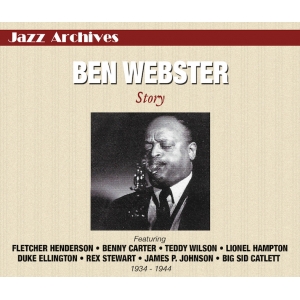Votre panier
Il n'y a plus d'articles dans votre panier
Liste des produits et biographie de Ben WEBSTER
Musicien américain, ténor
Voir la biographie
Ben WEBSTER
1957, The Sound of Jazz.... les caméras tournent, Billie Holiday chante face à onze musiciens dont trois saxophonistes ténors, trois personnages incroyables, inénarrables. On connait les images du film par coeur, on connait les chorus par coeur : Coleman Hawkins, Lester Young, Ben Webster, les trois plus grands ténors de jazz réunis ensemble autour de la voix inoubliable de Lady Day. Au début, il y avait Coleman Hawkins qui “inventa” l’instrument, puis Lester Young, son opposé (quoique...) et, entre les deux, de nombreux passages qu’emprunteront et déchiffreront à leur tour Hershel Evans, Chu Berry, Buddy Tate... Ben Webster se tient à l’affût. Depuis le début des années 30, ce pianiste de formation, né à Kansas City en 1909, hante les grandes formations avec son saxo qu’il a étudié avec Budd Johnson. On l’entend ainsi, au sein des sections d’anches et au détour d’un chorus dans les orchestres de Blanche Calloway, Bennie Moten, Andy Kirk, Fletcher Henderson, Benny Carter, Willie Bryant, Cab Calloway, Teddy Wilson et quelques autres, et dans quelques séances fameuses avec Billie Holiday et Lionel Hampton par exemple. Mais c’est en 1940 qu’il explose littéralement : dans Cotton Tail, avec le big band de Duke Ellington qu’il vient de rejoindre (il y avait fait un bref passage en 1935), on découvre un soliste au discours véhément, agressif, au jeu dynamique et puissant qui éclate littéralement. Un nouveau style est né.
Ben Webster est à la base de la lignée des ténors velus, hurleurs, “rentre dedans”, les shouters -Arnett Cobb est son premier disciple-, qui va en quelque sorte prolonger le jazz classique avec son apparente simplicité et son caractère dansant, lui conserver son aspect et son impact populaire, et le renouveler en imposant le ténor comme principal instrument soliste des ensembles orientés vers le rhythm and blues, puis le rock’n roll, la soul music et jusqu’au jazz funky et au free jazz -Archie Shepp en faisant une éclatante démonstration. La place considérable de Ben Webster dans l’histoire du jazz est encore renforcée par celle qu’il occupe dans l’évolution de la musique : parallèlement à ses qualités impressionnantes de torride swingman, il développe un travail sur le son -une ampleur et une profondeur inégalée-, le growl, le grain du ténor, les effets de souffle, de chuchotements, qui se traduisent merveilleusement dans le blues et les ballades (il invente une nouvelle façon de jouer les ballades qui fait toujours références aujourd’hui). Dès lors, et après plus de trois ans chez le Duke (plus quelques mois en 48/49), il se produit essentiellement en soliste, jouant avec Sidney Catlett, Jay McShann, Count Basie, le JATP, ses propres formations et enregistrant de nombreux disques dont un avec Art Tatum (1956) et un avec Coleman Hawkins (1957). En 1965, Ben Webster choisit de s’installer en Europe et devient l’attraction des festivals et des clubs comme le Paradiso d’Amsterdam, ville qu’il a choisit d’habiter et où il s’éteindra en 1973. A Paris, un an auparavant, en compagnie d’un Trio Arvanitas attentif et amoureux de sa musique, Ben Webster enregistrait, sur l’avant dernier disque de sa grande carrière, un choix de morceaux qu’il affectionnait et qu’il savait modeler et remodeler avec son sens aigü de la construction, de la phrase, des notes franches (définitives) et des sons les plus sensuels, donnant à ces thèmes la présence qui seule les rends intemporels. Jean Buzelin.
The year is 1957, the programme is called The Sound of Jazz, and the TV cameras are rolling. Billie Holiday is singing in the company of eleven top musicians, among them three tenor-saxophonists, a trio of all-time greats together on a single stage. The event almost defies description, yet the image remains indelible: Coleman Hawkins, Lester Young and Ben Webster, the three greatest tenors in the history of jazz, playing alongside the unforgettable Lady Day. Once upon a time, it was Coleman Hawkins who “invented” the tenor-sax, then along came Lester Young to “reinvent” it. Young was the stylistic opposite of Hawkins (although …), the latter having meantime spawned such eminent disciples as Herschel Evans, Chu Berry, Buddy Tate and … the magnificent Ben Webster. Since the dawn of the 1930s, this pianist-turned-saxophonist, born in Kansas City in 1909, had been frequenting the big bands of Blanche Calloway, Bennie Moten, Andy Kirk, Fletcher Henderson, Benny Carter, Willie Bryant, Cab Calloway, Teddy Wilson and one or two others. He had also turned up in some now famous sessions with Billie Holiday and Lionel Hampton. But it was in 1940 that he first made his real mark, bursting onto the scene with his memorable contribution to the Duke Ellington orchestra’s Cotton Tail. Ben at this time had just joined Duke (although he had spent a brief spell with the band back in 1935), and he promptly proved himself a vehement, aggressive, dynamic player. Ben Webster was explosive: and he had something new to offer.
Ben, the forerunner of the hard-hitting, “shouting” tenors (with Arnett Cobb his first disciple), was about to breathe new life into classic jazz. On the one hand, he preserved all its apparent simplicity and danceability, the very ingredients that ensured its popularity; on the other, he forged ahead to impose the tenor-sax as a major solo voice, one that would dominate jazz forms still to come — rhythm-and-blues, rock-and-roll, soul, funk and even free-form (witness Archie Shepp).
Ben Webster’s place in jazz history is all the more secure for his notable contribution to the evolution of the music. Quite apart from his qualities as a torrid swingman, he developed the sound of the tenor-saxophone , imparting to it unequalled breadth and depth. From the grainy growl to the breathy whisper, he enlarged the spectrum of the instrument, and in so doing invented a new approach to the interpretation of ballads and slow blues that to this day remains a model of its kind. After more than three years with Duke (plus a few further months in 1948-49), Ben moved on to pursue an essentially solo career, appearing with Sidney Catlett, Jay McShann, Count Basie, Jazz At The Philharmonic and numerous groups of his own. He made an impressive quantity of records, two of his landmark recordings being with Art Tatum in 1956 and Coleman Hawkins the following year. In 1965, Ben Webster settled in Europe, instantly becoming a major concert and festival attraction. He was also, of course, a big favourite in such clubs as the Paradiso in Amsterdam, his home city for the remainder of his life. A year before his death in 1973 he visited Paris, where he recorded with the Georges Arvanitas Trio, a group that loved and admired his music. This would, sadly, turn out to be the penultimate recording of a long, distinguished career, and it was perhaps with a certain premonition that Ben selected some of his favourite pieces. With his immaculate sense of construction and phrasing, his mastery of the appealing contrast between aggression and sensuality, Ben Webster invests these themes with a presence that renders them truly timeless. Adapted from the French by Don Waterhouse
Less

